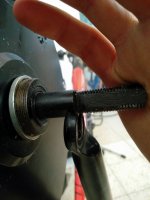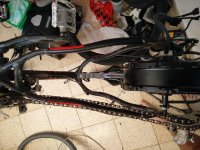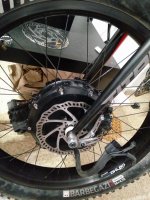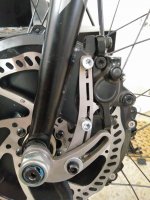thunderstorm80
1 kW
- Joined
- Mar 29, 2016
- Messages
- 383
Hey everyone,
Today I got the TC4080 crown motor, and I mounted it on the fork and also tried on the rear dropout.
First, I mounted it on the fork, as my original plan was. Since the fork of a fat-bike is 135mm OLD + it's made from rigid steel with 9mm dropouts (Not QR!) - it was perfect for oversized rear motor as the crown:

In this pic you can see how the motor's 140mm axle width is a bit wider than the 135mm OLD.
Widening the fork a bit (with very little effort, and the motor is in!

I can assume such 5mm stretching is nothing for a steel fork, right?
However, I don't have much clearance with extending the rotor (with spacers) towards the caliper, due to the motor-cable-exit interfering.
Then I tried to see if it can fit within the 190mm of the rear dropout:

Note how barely it extends beyond the dropouts. If it was just 2cm more, it would have made a match! (I would have preferred rear motor for offroad, but there is no high power DD for rear fat-bike axles, yet)
I was thinking - if there is any mechanical way, to secure it to the frame within those limits? (is there a way to extend the axle?)
The 2 torque arms can go inside as there is plenty of space. However, the rotor fitting would be a great challenge:

Note how -FAR- the caliper from the rotor's threads. Spacers cannot be used more than few mm's due to the motor's cable preventing it.
However, it was nicely "dished" when spacing it evenly between the dropouts:

This is where I thought - I saw I can actually press the two frame sides so I can reduce the OLD by few centimeters. But, I fear that for aluminium frame, such bending reduces it's strength, and can cause a failure while riding. Is it true, or is it ok to do so ?
I will finish by reminding that even for a front-motor solution, I do not plan on pulling thousands of watts through it! The traction would be limited, but such big DD motor would be excellent assistant at slow climbs (together with the rear leg-power - 2x2), and with the Phaserunner I can very easily limit my max torque on the fly. (together with CA v3.1)
Today I got the TC4080 crown motor, and I mounted it on the fork and also tried on the rear dropout.
First, I mounted it on the fork, as my original plan was. Since the fork of a fat-bike is 135mm OLD + it's made from rigid steel with 9mm dropouts (Not QR!) - it was perfect for oversized rear motor as the crown:

In this pic you can see how the motor's 140mm axle width is a bit wider than the 135mm OLD.
Widening the fork a bit (with very little effort, and the motor is in!

I can assume such 5mm stretching is nothing for a steel fork, right?
However, I don't have much clearance with extending the rotor (with spacers) towards the caliper, due to the motor-cable-exit interfering.
Then I tried to see if it can fit within the 190mm of the rear dropout:

Note how barely it extends beyond the dropouts. If it was just 2cm more, it would have made a match! (I would have preferred rear motor for offroad, but there is no high power DD for rear fat-bike axles, yet)
I was thinking - if there is any mechanical way, to secure it to the frame within those limits? (is there a way to extend the axle?)
The 2 torque arms can go inside as there is plenty of space. However, the rotor fitting would be a great challenge:

Note how -FAR- the caliper from the rotor's threads. Spacers cannot be used more than few mm's due to the motor's cable preventing it.
However, it was nicely "dished" when spacing it evenly between the dropouts:

This is where I thought - I saw I can actually press the two frame sides so I can reduce the OLD by few centimeters. But, I fear that for aluminium frame, such bending reduces it's strength, and can cause a failure while riding. Is it true, or is it ok to do so ?
I will finish by reminding that even for a front-motor solution, I do not plan on pulling thousands of watts through it! The traction would be limited, but such big DD motor would be excellent assistant at slow climbs (together with the rear leg-power - 2x2), and with the Phaserunner I can very easily limit my max torque on the fly. (together with CA v3.1)




